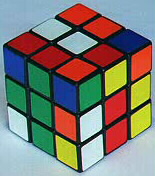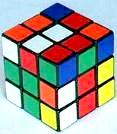

Fig. 5a Fig. 5b
STEP TWO: CENTER SECTION EDGE PIECES
In Step Two of The Ultimate Solution to Rubik's Cube you will have two objectives which are to be met simultaneously. You will use the Edge Piece Series to move a central section edge piece from the top face into its proper position and orientation in the center section. You will repeat this process until three of the center section edge pieces are in place.
As you carry out this process some of the pieces you will be moving will be top section edge pieces. Make sure you carry out the Edge Piece Series so that, if possible, the top edge pieces wind up with their top color on the top face of the cube. This step is complete when:
a. three edge pieces are in place in the center section,
b. three top edge pieces have their top color on the top face of the cube,
c. one top edge piece is in the center section and
d. the fourth center section edge piece is in the top section of the cube.
In the beginning it is possible that one or more center section edge pieces are already in place. Fine. But it is also possible that one or more are in the proper position but with the wrong orientation. Tough. You will have to remove it (them), also with an Edge Piece Series.
Remember that a center section edge piece may be moved into proper position and orientation with that edge piece starting above either of the faces with one of the edge piece colors. The orange/green edge piece in Fig. 5a (at top/right) could be moved into place at front/right if it is treated as Edge Piece #1. But this would be a bad idea because the white/red edge piece would be inverted in the process and we would have reduced the number of top edge pieces with their top color on top of the cube from one to none.


Fig. 5a
Fig. 5b
On the other hand we could treat the orange/green edge piece as Edge Piece #2 in Fig. 5a (red/white would be #1) or rotate the top face 90o clockwise (giving Fig. 5b) and treat orange/green as Edge Piece #3. The red/yellow edge piece would be #1. In either case the orange/green edge piece moves into the proper position and orientation and the red/white edge piece will continue to have its white color on the top face of the cube.
But we need to get more white edge piece faces on the top face of the cube. In Fig. 5c the red/green edge piece belongs at front/right. If we treat the red/green edge piece as #1 an Edge Piece Series will cause the orange/white edge piece to come to the top of the cube with its orange face on top, not white. On the other hand if we treat the yellow/red edge piece as #1 then red/green is #2 and orange/white would be #3. Orange/white would come to the top of the cube with its white face on top (since edge piece #3 always inverts).


Fig. 5c
Fig. 5d
Or we could rotate the top face 90o counterclockwise (giving Fig. 5d) and apply
an Edge Piece Series with the red/green edge piece as #3. The orange/white edge piece will
be #1 and the red/white edge piece will be #2. The orange/white edge piece will come to
the top of the cube with its white face on top and the white face of the red/white edge
piece will remain on top. We will now have two white faces on the top face of the cube.
Continue this process until three center section edge pieces are in place, three top edge pieces have their top color on top and the fourth top edge piece is in the center section. The fourth center section edge piece will be on the top of the cube.
If you should, by chance, properly place three center section edge pieces but have only two top edge pieces with their top colors on top, then apply one more Edge Piece Series in which all of the pieces involved are top edge pieces. The top edge piece in the center section comes to the top with its top color on top and the top edge piece which does not have its top color on top moves into the center section.
You should note that you do not always have to complete the fourth turn of the Edge Piece Series. Whenever the fourth turn is a turn of the top face it does not need to be made because a turn of the top face can have no effect on the bottom face. Remember, the Edge Piece Series was devised not only to put center section edge pieces into proper position/orientation but also to prevent the movement of edge pieces on the bottom face.